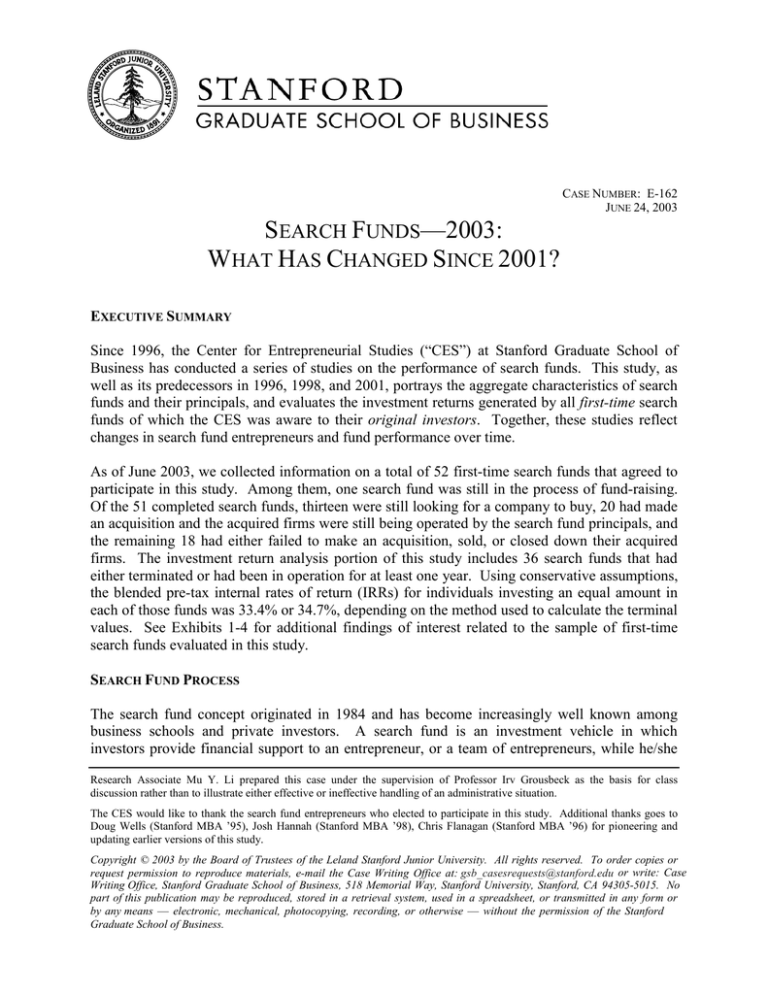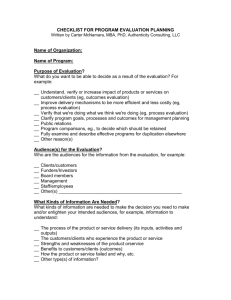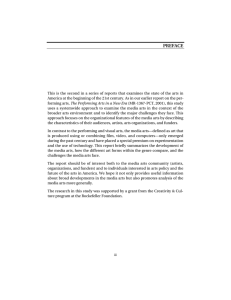
CASE NUMBER: E-162
JUNE 24, 2003
SEARCH FUNDS—2003:
WHAT HAS CHANGED SINCE 2001?
EXECUTIVE SUMMARY
Since 1996, the Center for Entrepreneurial Studies (“CES”) at Stanford Graduate School of
Business has conducted a series of studies on the performance of search funds. This study, as
well as its predecessors in 1996, 1998, and 2001, portrays the aggregate characteristics of search
funds and their principals, and evaluates the investment returns generated by all first-time search
funds of which the CES was aware to their original investors. Together, these studies reflect
changes in search fund entrepreneurs and fund performance over time.
As of June 2003, we collected information on a total of 52 first-time search funds that agreed to
participate in this study. Among them, one search fund was still in the process of fund-raising.
Of the 51 completed search funds, thirteen were still looking for a company to buy, 20 had made
an acquisition and the acquired firms were still being operated by the search fund principals, and
the remaining 18 had either failed to make an acquisition, sold, or closed down their acquired
firms. The investment return analysis portion of this study includes 36 search funds that had
either terminated or had been in operation for at least one year. Using conservative assumptions,
the blended pre-tax internal rates of return (IRRs) for individuals investing an equal amount in
each of those funds was 33.4% or 34.7%, depending on the method used to calculate the terminal
values. See Exhibits 1-4 for additional findings of interest related to the sample of first-time
search funds evaluated in this study.
SEARCH FUND PROCESS
The search fund concept originated in 1984 and has become increasingly well known among
business schools and private investors. A search fund is an investment vehicle in which
investors provide financial support to an entrepreneur, or a team of entrepreneurs, while he/she
Research Associate Mu Y. Li prepared this case under the supervision of Professor Irv Grousbeck as the basis for class
discussion rather than to illustrate either effective or ineffective handling of an administrative situation.
The CES would like to thank the search fund entrepreneurs who elected to participate in this study. Additional thanks goes to
Doug Wells (Stanford MBA ’95), Josh Hannah (Stanford MBA ’98), Chris Flanagan (Stanford MBA ’96) for pioneering and
updating earlier versions of this study.
Copyright © 2003 by the Board of Trustees of the Leland Stanford Junior University. All rights reserved. To order copies or
request permission to reproduce materials, e-mail the Case Writing Office at:JVEBFDVHVUHTXHVWV#VWDQIRUGHGX or write: Case
Writing Office, Stanford Graduate School of Business, 518 Memorial Way, Stanford University, Stanford, CA 94305-5015. No
part of this publication may be reproduced, stored in a retrieval system, used in a spreadsheet, or transmitted in any form or
by any means –– electronic, mechanical, photocopying, recording, or otherwise –– without the permission of the Stanford
Graduate School of Business.
Search Fund – 2003: What Has Changed since 2001? E-162
p. 2
or the team endeavors to identify and acquire a privately held company. The search fund process
involves more than simply making an investment—it consists of up to four stages: fund-raising,
search and acquisition, operation, and eventual sale or other event providing shareholder
liquidity. For specific metrics of these stages, please refer to Exhibits 1-4.
Stage One: Raising Initial Capital
Search funds are usually structured as limited liability companies. The typical profile of a firsttime “search funder” was, until this study, a relatively new MBA graduate who did not possess
much, if any, general management or operating experience. However, as will be illustrated
shortly, search funds formed since 2001 seem to be headed by principals with more operating
experience.
The search funder begins by writing a business plan that describes what he or she hopes to
acquire in general terms, emphasizing the acquisition process and criteria. The document is used
to assemble a group of private investors who will provide advice and assistance, as well as
contribute the initial capital to pay the search funder a salary and cover administrative expenses
during the search process.1 Typically, this group consists of ten or more investors who purchase
one or several units of the initial capital of the search fund, at about $20,000 to $25,000 per unit.
On average, search funders raise $300,000 to $400,000 in this initial round in about four to five
months, although some can take as many as nine months (see Exhibit 2).
Stage Two: Identifying and Making an Acquisition
Compared to raising initial capital, searching for an acquisition target and completing the
transaction is more time-consuming—a process that can easily take over a year. The length of
the second stage is also more varied from fund to fund. The general economic environment,
industry characteristics, sellers’ willingness to sell, and regulatory issues are among the factors
that can prolong or derail the acquisition process. Depending on the complexity of the deal, it
can take six months or more from the time the search funder signs the letter of intent until he or
she closes the deal.
In order to mitigate operating and investment risk, search funders generally target industries that
are not subject to rapid technology change, are fairly easy for them to understand, and are in
fragmented geographical or product market. Presumably, industries fragmented across one or
more dimensions offer enhanced opportunities for growth, either through acquisition or product
or market extension. Within the preferred industries, companies are targeted based on their
sustainable market position, their history of positive, stable cash flows, and opportunities for
improvement and growth. Search funders and their investors tend to prefer healthy, profitable
companies with a proven second-tier management team to turn-around situations. By adhering
to such a disciplined list of acquisition guidelines, search fund investors have been able to greatly
reduce the risks typically associated with investing in individuals possessing little operating
experience.
When a target is identified, each search fund investor is given the pro-rata right of first refusal on
the capital required to fund the acquisition. Commonly, the search fund investment is stepped up
by a certain percentage (e.g. 50%) in the acquisition round, irrespective of whether the investor
1
There are rare cases where search funders seek full-time or part-time employment for financial support while searching.
Search Fund – 2003: What Has Changed since 2001? E-162
p. 3
decides to participate in the transaction. In addition to the follow-on equity investment from the
original team of investors, the funds for acquisition can come from a combination of other
sources: seller’s debt, bank loans, and equity financing from new investors. Investor debt,
commonly in the form of subordinated debt, may also be added to the capital structure.
If the target is a sustainable business with only modest growth, oftentimes it will sell for a
multiple equivalent to 40% to 100% of revenues. Purchase prices generally range from $5
million to $20 million, with the equity portion of the completed transaction between $1 million
and $7 million, or between 10 % and 75% of the total purchase price. The acquisition is
expected to be at fair market value. Ideally, the acquired company would provide adequate cash
flow and be without significant debt service, so that the short-term survival of the company does
not rely on immediate, significant improvement in company performance by the search funders.
If the initial capital is exhausted before a target can be identified, search funders may choose
either to close the fund or to solicit additional funding to continue the search. For the purpose of
this study, the “initial capital” or “initial investment” includes all investments made prior to
acquisition or liquidation.
Stage Three: Operation and Value Creation
After completing the acquisition, search funders will recruit a board of directors for the
company, which often includes substantial representation from the initial investors. In the first
twelve to eighteen months after the acquisition, search funders typically make few radical
changes to the existing business, opting instead to gain management familiarity.2 After
becoming comfortable operating the business, search funders then begin to make changes as they
see fit.
After a company is purchased, search funders can create value through one or more of the
following ways: revenue growth, improvements in operating efficiency, appropriate use of
leverage, or expansion. Typically, these means of creating value are not mutually exclusive;
ideally, more than one will apply to a search fund investment. Revenue growth may result from
internal growth initiatives, pricing improvements or scale attained from acquiring like
businesses. Original search fund investors may be invited to participate in subsequent
acquisitions and these amounts are included in computing the rates of return in this study.3 After
a growth plan has been executed, the resulting company can be expected to be much more
valuable, even when sold at the same multiple for which it was purchased. Improvements in
operating efficiency can obviously make a business more profitable. Purchasing a company with
leverage can enable the equity in the business to grow as debt is paid off successfully.
RESEARCH METHODOLOGY AND POTENTIAL BIASES
In May 2003, the CES conducted a survey of search funds included in the 2001 study and new
search funds that it had become aware of since June 2001. For each of the search funds, we
collected information on demographic characteristics of search funders as well as key metrics of
fund-raising, acquisition, company operations, and liquidity events. The response rate for search
2
And because of this, the series of search fund studies excludes companies with fewer than twelve months of operation from the
computation of IRRs.
3
Please note that IRRs thus calculated do not represent the rates of return to investors who did not contribute the initial search
fund capital.
Search Fund – 2003: What Has Changed since 2001? E-162
p. 4
funds identified after the 2001 study was 100%. For the search funds included in the 2001 study,
the response rate was close to 100%; for the few cases where the company or search funders
could no longer be contacted, the CES sought to update the relevant information from such
secondary sources as search fund investors. Therefore, the extent of “selection bias,” where the
willingness to participate and disclose information by the respondents may skew the true
performance of all search funds, is limited to the selection bias of the 2001 study, where 46 out
of a universe of 62 search funds elected to participate. The absence of additional selection bias
in this current study provides the basis for inter-temporal comparison of IRRs across 2001 and
2003.
When interpreting IRRs computed in this study, it is important to note the following additions to
the group of companies from which we derived the 2001 IRRs. First of all, at the time of the
2001 study, three funds were still actively searching. Their search outcomes and financial
performances, now available, are included here. Furthermore, the 2001 study excluded two
funds that had been managing their companies for less than a year, and they are also included. In
addition, the 2001 study excluded one fund because at the time it was pursuing a strategy of
industry roll-up. However, the company subsequently decided to opt for a more conventional
search fund strategy and its performance is thus included. Finally, IRR calculations include
search funds that closed down (failed to buy a company) after the 2001 study.
In this study, IRRs are calculated on a cash flow basis, with cash infusions or distributions
treated as occurring on the first day of the month (when month and year were available) or the
first day of the year (when only the year was available). For funds that had either sold or
liquidated their companies or closed their funds down without having purchased a company, the
terminal value was straightforward. In the cases of companies still under search fund
management, we made several assumptions in order to determine investor returns. If a liquidity
event had recently taken place at a company, we used the value of the event to determine a
current valuation. Otherwise, we used two methodologies. The first assumed that companies
were sold at the purchase multiple of EBITDA paid at acquisition, and the second assumed that
companies were sold at a “current market multiple” of EBITDA for their industry, minus a 30%
private company minority interest discount.4 The 30% discount, although arbitrary, seems
conservatively realistic for the purposes of this study. It is also used for consistency with the
2001 study. In all cases, the study assumes that all debt was repaid and that funds were
disbursed to the original search fund investors in proportion to the equity and/or subordinated
debt owned by them. All returns are calculated on a pre-tax basis to investors.
Finally, to adjust for variations in deal size, we computed a separate set of IRRs under the
assumption that a representative investor invested equal amounts in each search fund—$20,000
as the initial capital and $100,000 for acquisition. The difference between the two amounts
reflects the pattern that investment in the acquisition round was usually several times the initial
search fund investment. In computing the aggregate measures of search fund IRRs, in addition
to standardizing investment size, we assumed that all search funds started on the same date, and
uniformly adjusted the timing of all subsequent cash flow events accordingly. In other words, if
one fund finalized its acquisition in 12 months and another in 24 months, those were the periods
of time used although both were assumed to have started on the same date. Standardizing deal
sizes had the effect of slightly augmenting the blended IRR (see Exhibit 4).
4
EBITDA = Earnings Before Interest, Taxes, Depreciation and Amortization
Search Fund – 2003: What Has Changed since 2001? E-162
p. 5
Like its predecessors, this study includes only first-time search funds, thus excluding “serial
search funders” whose track record may imply different fund-raising techniques, management
and operational capabilities, and perceptions by investors and sellers. Since the focus of the CES
search fund series is to understand the returns from investing with a new entrepreneur in an
industry in which he or she has limited prior experience, we exclude the non first-time funds
from this study. For consistency, this study also maintains the tradition of excluding search
funds that later became start-ups.
Lastly, the statistics of this report and its predecessors are derived from a relatively small sample.
As is common to all small samples, the statistical significance of aggregate metrics is limited and
is subject to the presence of a few out-liers. Entrepreneurs and investors interested in search
funds are encouraged to pursue more intensive investigations.
CHANGES SINCE 2001
The global economic environment underwent a significant transition between 2001 and 2003.
Particularly in the United States, where the majority of search funds and their acquired
companies were located, the 2001-2002 recession dealt a severe blow to many sectors of the
economy, especially high-technology. How have the changes in the business environment
affected the emergence of new search funds and the performance of existing search funds?
There are many factors that could either inhibit or promote the creation and success of search
funds: the willingness of recent business school graduates to pursue entrepreneurial careers,
sellers’ attitudes, investors’ appetite for risky ventures, availability and cost of professional
services and facilities, ease of accessing bank credit, level and volatility of customer demand,
and intensity of competition, to name just a few.
To render a tangible picture of the aggregate effects of these factors, this study presents findings
in the following four categories: search funder profile, search fund characteristics, acquisitions,
and search fund company performance. The figures for the “Pre-2001” columns in the
corresponding exhibits may differ from those previously reported due to the addition of one pre2001 search fund that was not known to the CES at the time of the 2001 study.
Search Funder Profile
Exhibit 1 demonstrates how the profiles of search funders varied between those that were
established before and after June 2001, the time of the last study. The most striking difference in
search funders’ backgrounds is the increased incidence of ex-managers and ex-entrepreneurs in
the pool of search funders, from a combined 8% in 2001 to 40% in 2003. The proportion of
investment bankers also fell significantly from 23% to 10%.
Statistics on age and number of post-MBA years seem to suggest that in 2003, most search
funders still conformed to the typical profile of a relatively young, recent business school
graduate. However, the presence of senior search funders in 2003 also indicates that a small
number of highly experienced entrepreneurs/executives have ventured into the world of search
funds, in most cases as partners of younger, less experienced search funders. This pattern of
partnership is consistent with the assumption that search funders sought the operational expertise
and credibility of their experienced partners to facilitate fund-raising, acquisition, and company
management. To validate this hypothesis would require more in-depth study of individual funds,
which is beyond the scope of this study.
Search Fund – 2003: What Has Changed since 2001? E-162
p. 6
Finally, Exhibit 1 reflects the continued lack of women search funders in 2003.
Key Search Fund Metrics: Fund-Raising and Search
How are the post-2001 search funds different from those established prior to 2001? Several
distinctions stand out. First, about 59% of post-2001 search funds were headed by more than one
principal, versus 32% of pre-2001 funds (see Exhibit 2).5
The second difference, which is rather surprising given the economic downturn, is that the post2001 funds tended to have raised more initial capital than their pre-2001 counterparts. This
could be a reflection of the higher anticipated cost of search (and thus the need for capital), or
investors’ greater recognition and interest in search funds despite the general economic
environment. Without further data, it is difficult to tease out which effect dominated the changes
in fund-raising.
Post-2001 search funders spent four to five months, on average, raising their necessary capital.
Although the corresponding figures were not collected for the 2001 survey, there seems to have
be little variation in the time spent on initial fund-raising.
As of April 2003, sixteen post-2001 funds had spent on average 11.7 months searching for an
appropriate acquisition target (the median is 8.5 months, see Exhibit 2). When comparing these
figures with those from the 2001 study, it should be noted that most of these funds intended to
continue their search beyond April 2003, thereby increasing the time taken to either complete an
acquisition or close down. Of the sixteen post-2001 funds, three had purchased a company by
June 2003 and all of them took more than twelve months to complete the search and close a
transaction. The corresponding figures for 2001 are for funds that had terminated their search.
They differ slightly from those reported in the 2001 study because four funds (one not known to
the CES plus three still actively searching at that time) are included in this study.
For the 2003 survey, we collected information on targeted industries from the post-2001 search
funds, the results of which are tabulated in Exhibit 2. Viewed in conjunction with the sectoral
distribution of actual acquisitions made by pre-2001 search funds, services and manufacturing
continued to be the focus of search funds, although interest in manufacturing companies rose
relatively in 2003. However, until the post-2001 funds complete their acquisitions, such a
comparison would continue to be preliminary.
The 2003 survey also asked the post-2001 search funders to identify the geographic regions they
targeted for their search, a piece of information that was not previously collected in 2001. Seven
of these sixteen funds had little geographic preference, and the remaining funds focused on
rather broadly defined regions as the mid-Atlantic, the Northeast, or the West Coast.
Key Search Fund Company Metrics: Acquisition and Financial Performance
Exhibit 3 lists a number of key metrics regarding the acquisitions made by search funds in our
sample. A small number of these funds elected to disclose only partial information about their
transactions. Because the sample consists mainly of firms that had already completed their
5
However, no post-2001 funds had more than two partners.
Search Fund – 2003: What Has Changed since 2001? E-162
p. 7
acquisitions by 2001, the tabulated figures are consistent with the 2001 study. The only notable
difference is the slightly higher median profit margin (at purchase) of 16.5% vs. the previous
14.6%.
How do returns to original search fund investors in 2003 differ from those in 2001? First of all,
individual IRRs varied widely, ranging from -100% (implying a complete loss of investor
capital) to over 80% per year for a highly successful company or companies (see Exhibit 4). The
distribution of IRRs is skewed with about 39% of the funds from which we had sufficient data to
calculate IRRs resulting in complete or near complete loss of investor capital. Over half of these
situations involved the failure of search funders to identify or execute an acquisition. The
remaining returns distribute fairly evenly over the -50% to 50% range, with few attaining higher
than 50% IRRs. However, search fund investments, although relatively risky if undiversified,
may not be as unattractive as the high “failure” rate suggests. Because the initial capital raised
by search funds is generally modest compared to the acquisition rounds, to accurately gauge the
quality of search funds as an investment opportunity in general, we need to standardize the funds
to adjust for deal size and timing differences. Adopting the methodology described in the
previous section, we calculated the blended IRR for a person investing an equal amount in each
of the 36 “first-time” search funds at the same start date to be (also see Exhibit 4):
•
•
33.4% if the terminal value was based on the original purchase price/EBITDA multiple
34.7% if the terminal value was based on a 30% discount to the current estimated
multiple
Consistent with the hypothesis that the business environment had deteriorated as a result of the
2001-2002 recession, the aggregate IRR measures thus calculated are lower, albeit slightly, than
the corresponding 36.8% and 35.9% reported in the 2001 study.
Search Fund – 2003: What Has Changed since 2001? E-162
p. 8
Exhibit 1
Comparison of Search Funder Profile: Pre-2001 vs. Post-2001
Categories
Professional Background:
Management Consulting
Investment Banking
Sales
Venture Capital
Line/General Management
Marketing
Law
Operations
Entrepreneur
Accounting
Engineering
Military
Insurance
Private Equity
Others 3
Age at Start of Search:
Minimum
Median
Maximum
Gender:
Male
Female
Number of Post-MBA Years before
Search Fund: 4
Minimum
Median
Maximum
Pre-2001 1
Post-2001 2
26%
23%
12%
8%
5%
5%
4%
4%
2%
2%
2%
2%
2%
1%
0%
23%
10%
1%
3%
27%
2%
0%
7%
13%
0%
0%
1%
1%
5%
7%
26
30
35
28
31
60
96%
4%
100%
0%
0
2
10
Notes:
1. Includes one pre-2001 search fund not known to the CES at the time of the 2001 study.
2. From all funds formed after June 2001, including one that was still actively raising funds as of
6/2003.
3. Includes teaching, professional sailing, geology, government, and case-writing for business
school.
4. For search funders with MBA only; similar data were not collected for 2001.
Search Fund – 2003: What Has Changed since 2001? E-162
p. 9
Exhibit 2
Aggregate Metrics of Search Funds: Pre-2001 vs. Post-2001
Pre-2001 1
Post-2001
68%
32%
41%
59%
Amount of Initial Capital Raised:
Minimum
Median
Maximum
$40,000
$290,000
$1,000,000
$125,000
$350,000
$10,000,000
Number of Search Fund Investors:
Minimum
Median
Maximum
2
12
25
1
12.5
20
Categories
Number of Principals: 2
Single
Partners
Number of Months Fund-Raising: 3
Minimum
Median
Maximum
Number of Months Searching:
Minimum
Median
Maximum
Targeted Industries: 4
Service
Manufacturing
Manufacturing/Service Combination
Distribution
Retail/Service Combination
Retail
Media
Utilities
No Preference
1
4.5
9
5
18
54
50%
19%
12%
8%
8%
4%
(as of 4/2003)
0
8.5
18
30%
30%
0%
5%
3%
0%
13%
6%
13%
Notes:
1. Includes one pre-2001 search fund not known to the CES at the time of the 2001 study.
2. The 2003 figures were computed from all funds formed after June 2001, including one that was
still actively raising funds as of 6/2003. All other categories exclude the actively fund-raising
entity.
3. Similar data were not collected for 2001.
4. The 2001 column refers to the sectoral distribution of acquired search fund companies, while the
2003 column refers to the distribution of industries targeted by sixteen post-2001 search funds,
excluding the actively fund-raising entity.
Search Fund – 2003: What Has Changed since 2001? E-162
p. 10
Exhibit 3
Summary Statistics for All Search Fund Acquisitions 1
Minimum
Median
Maximum
Purchase Price
$ 0.56 M
$ 5.4 M
$ 30.6 M
Search Fund Investor Capital Raised for
Company Purchase
Company Revenues at Purchase
$ 0.0 M
$ 2.0 M
$ 7.0 M
$ 0.37 M
$ 7.1M
$ 43 M
Company EBITDA at Purchase
$ (1.6) M
$ 1.0 M
$ 4.5 M
(3.7)%
16.5%
42.1%
Purchase Price / Revenue Multiple
0.3x
0.9x
3.4x
Purchase Price / EBITDA Multiple 2
2.3x
5.3x
12.5x
12
80
740
Company EBITDA Margin at Purchase
Company Employees at Purchase
Notes:
1. Summary statistics are based on financial information provided by search funders themselves. In many
cases, this financial information has not been audited. Information regarding a small number of
acquisitions was incomplete.
2. The minimum is calculated by excluding all negative EBITDAs.
Search Fund – 2003: What Has Changed since 2001? E-162
p. 11
Exhibit 4
Search Fund IRRs to Original Investors 1
2001 Study
Figures
2003
(100)% 2
(100)%
Individual IRRs:
Minimum
25th Percentile
Median
(100)%
17.6%
75th Percentile
Maximum
Aggregate IRRs with Same Starting
Dates:
Actual Cash Flows with Original EBITDA
Multiples
Normalized Cash Flows with Original
EBITDA Multiples
Actual Cash Flows with Estimated Current
Multiples minus 30% Discount 3
Normalized Cash Flows with Estimated
Current Multiples minus 30% Discount 3
(23.7)%
21.9%
98.3%
84.8%
37.6%
31.7%
36.8%
33.4%
35.7%
33.0%
35.9%
34.7%
Notes:
1. Summary statistics are based on financial information provided by 36 funds that were either closed, or have
sold or operated acquired companies for more than a year. In many cases, this financial information has
not been audited.
2. Negative 100% in the “Minimum” column equates to a total loss of investor capital.
3. When firms elected not to provide an estimate of current EBITDA multiple, the original multiple is used.
When respondent provided a range of EBITDA multiple estimates, we used the average figure.









